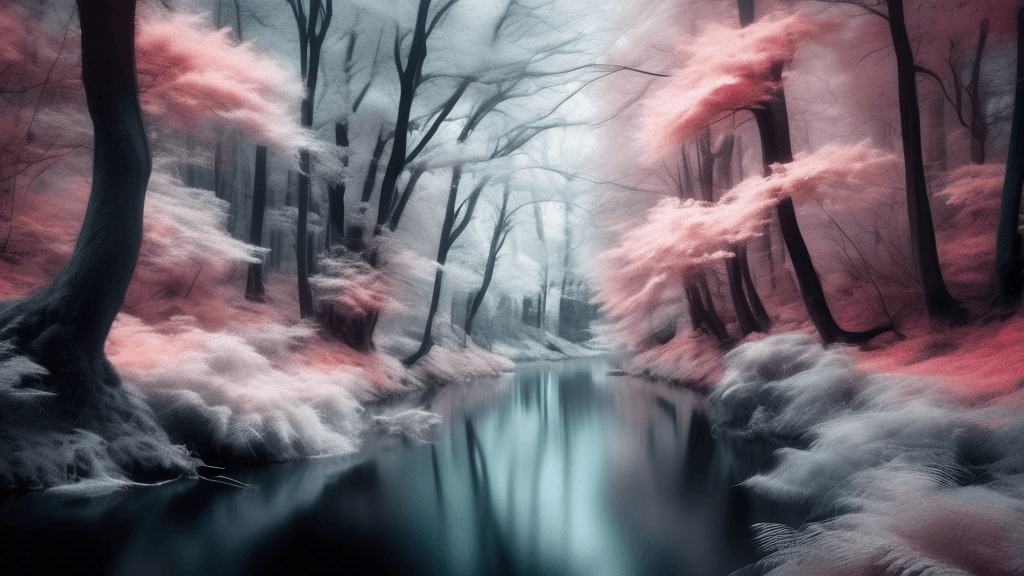
Capturing the Invisible: The Art of Infrared Landscape Photography
Share
Introduction to Infrared Landscape Photography
Infrared (IR) photography remains one of the most fascinating techniques in the world of photography. By capturing light from the infrared spectrum, which is invisible to the naked eye, photographers are able to create surreal and dreamlike images of landscapes that transform familiar scenes into something otherworldly. But what exactly is infrared photography, and how can photographers harness its power to explore the unseen beauty of nature?
Understanding Infrared Photography
Infrared light refers to a spectrum of light that extends from the red edge of the visible light spectrum at about 700 nanometers (nm) to about 1 millimeter (mm) in wavelength. Most IR photography in landscapes uses wavelengths between 700 nm to 900 nm. This range is known as the near-infrared spectrum, sitting just beyond what is visible to human eyes.
Standard cameras are designed to block infrared light. However, by modifying a camera to remove this block or by using an infrared filter, photographers can capture this invisible spectrum. The results highlight contrasts in a unique way, as IR light behaves differently than visible light, particularly in how it is reflected off surfaces and absorbed by others.
Why Capture Landscapes in Infrared?
Landscapes offer a dynamic subject for infrared photography for multiple reasons:
- Vegetation: Chlorophyll in plants reflects IR light intensely, making them appear almost luminescent or snow-white in IR photos, providing a striking contrast to skies and water.
- Water and Sky: Water absorbs infrared and thus appears very dark or even black, providing a dramatic contrast to the brighter sky and vegetation.
- Atmospheric Haze: Infrared light cuts through atmospheric haze more effectively than visible light, allowing for clearer, more detailed distant landscape features.
Techniques for Infrared Landscape Photography
Mastering IR photography involves understanding both the technical aspects of capturing infrared light and the artistic nuances of composing a scene in a spectrum we cannot see with our eyes.
Choosing the Right Equipment
There are two main methods to achieve infrared photos - using an IR filter on the lens or converting a camera for infrared use. Filters, such as the Hoya R72, are a good starting point as they block visible light and only allow infrared light to pass through. On the other hand, converting a camera for infrared use typically involves removing the internal infrared-blocking filter, allowing the sensor to capture infrared light directly.
Setting the Scene
When composing an infrared image, the same principles of landscape photography apply, but with an awareness of how materials and surfaces interact differently with IR light. Composing images with a strong presence of foliage, clear skies, and structured water bodies can result in captivating contrasts and ethereal qualities.
The Aesthetic and Emotional Impact of Infrared Photography
IR photography can evoke emotions and provoke thought in ways traditional photography might not. The surreal landscapes it presents are often perceived as mysterious or ethereal, inviting viewers to question what they know about light, perception, and the natural world.
Notable IR photographers like Simon Marsden have often noted the ghostly, other-worldly feel of infrared photographs. Marsden mentioned in an array of interviews how IR photography allowed him to express the unseen, providing a visual manifestation of the mystical and ethereal themes he sought to explore.
Conclusion: A New Way of Seeing the World
Infrared landscape photography invites both photographers and viewers to see the world anew. It highlights aspects of our environment that are typically unseen and underappreciated, offering a fresh perspective that challenges our perceptions of reality.
If you're intrigued by the possibilities of infrared photography, why not give it a try? Whether you’re a seasoned photographer looking to expand your skills or a curious beginner eager to explore the boundaries of light and perception, the ethereal world of infrared landscape photography awaits. Remember, the only limit is your creativity.
Embarking on this journey will not only enhance your photographic skills but also deepen your appreciation for the subtle, unseen beauties of our world. Are you ready to capture the invisible?





